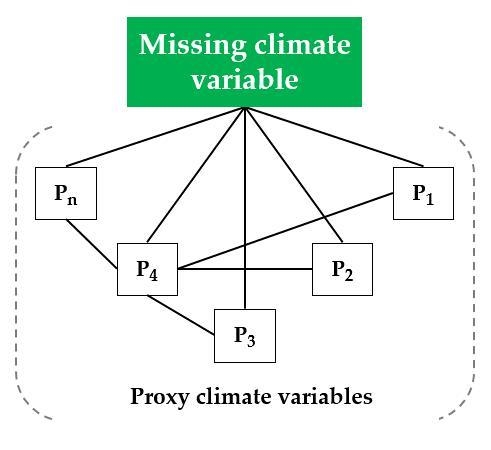Inferring Missing Climate Data for Agricultural Planning Using Bayesian Networks
Abstract
:1. Introduction
2. Methods
2.1. Study Region
2.2. Relative Humidity
2.3. Data
2.4. Variable Selection
2.5. Discretization
2.6. Model Structure and Parameters
2.7. Sensitivity Analysis and Model Validation
3. Results and Discussion
3.1. Sensitivity Analysis
3.2. Validation
3.3. Caveats
4. Conclusions
Acknowledgments
Author Contributions
Conflicts of Interest
Appendix A
| Dataset | Variable | Unit | Mean | S.D. | Median | Minimum | Maximum | Skewness | Kurtosis |
|---|---|---|---|---|---|---|---|---|---|
| RHDM | RH | % | 69.13 | 9.08 | 70.16 | 37.45 | 98.16 | −0.41 | −0.18 |
| PRCP | mm | 1.05 | 1.79 | 0.47 | 0.00 | 24.41 | 4.19 | 24.69 | |
| TMAX | °C | 29.76 | 3.33 | 29.27 | 10.00 | 42.35 | 0.24 | 0.94 | |
| Solar | MJ/m2 | 21.53 | 3.10 | 21.74 | 7.93 | 28.27 | −0.39 | −0.17 | |
| Wind | m/s | 3.37 | 1.73 | 2.85 | 0.77 | 11.51 | 1.08 | 0.64 | |
| TMIN | °C | 20.53 | 4.93 | 20.92 | −2.66 | 29.17 | −0.57 | −0.26 | |
| MRH | RH | % | 77.79 | 9.66 | 78.50 | 37.45 | 98.73 | 50.04 | 0.37 |
| PRCP | mm | 8.13 | 8.38 | 5.47 | 0.00 | 83.94 | −146.41 | 4.01 | |
| TMAX | °C | 28.75 | 3.05 | 28.48 | 10.00 | 42.35 | −5.03 | 1.71 | |
| Solar | MJ/m2 | 19.69 | 3.83 | 20.03 | 3.72 | 28.27 | 39.49 | −0.04 | |
| Wind | m/s | 2.83 | 1.58 | 2.32 | 0.63 | 11.81 | −109.93 | 1.35 | |
| TMIN | °C | 21.51 | 4.40 | 21.85 | −2.66 | 29.54 | 50.07 | −0.13 |
References
- Little, R.J.; Schenker, N. Missing data. In Handbook of Statistical Modeling for the Social and Behavioral Sciences; Arminger, G., Clogg, C.C., Sobel, M.E., Eds.; Springer: Boston, MA, USA, 1995; pp. 39–75. ISBN 978-1-4899-1292-3. [Google Scholar]
- Miller, D.; Robbins, M.; Habiger, J. Examining the challenges of missing data analysis in phase three of the agricultural resource management survey. In Proceedings of the Joint Statistical Meetings; American Statistical Association: Vancouver, BC, Canada, 2010; pp. 816–829. [Google Scholar]
- Frolking, S.; Qiu, J.; Boles, S.; Xiao, X.; Liu, J.; Zhuang, Y.; Li, C.; Qin, X. Combining remote sensing and ground census data to develop new maps of the distribution of rice agriculture in China. Glob. Biogeochem. Cycles 2002, 16, 38-1–38-10. [Google Scholar] [CrossRef]
- Smith, T.M.; Reynolds, R.W.; Livezey, R.E.; Stokes, D.C. Reconstruction of Historical Sea Surface Temperatures Using Empirical Orthogonal Functions. J. Clim. 1996, 9, 1403–1420. [Google Scholar] [CrossRef]
- Liu, D.L.; Scott, B.J. Estimation of solar radiation in Australia from rainfall and temperature observations. Agric. For. Meteorol. 2001, 106, 41–59. [Google Scholar] [CrossRef]
- Schneider, T. Analysis of incomplete climate data: Estimation of mean values and covariance matrices and imputation of missing values. J. Clim. 2001, 14, 853–871. [Google Scholar] [CrossRef]
- Acock, M.C.; Pachepsky, Y.A. Estimating missing weather data for agricultural simulations using group method of data handling. J. Appl. Meteorol. 2000, 39, 1176–1184. [Google Scholar] [CrossRef]
- Harris, E. Building scientific capacity in developing countries. EMBO Rep. 2004, 5, 7–11. [Google Scholar] [CrossRef] [PubMed]
- Wagner, C.S.; Brahmakulam, I.; Jackson, B.; Wong, A.; Yoda, T. Science and Technology Collaboration: Building Capability in Developing Countries; RAND: Pittsburgh, PA, USA, 2001; p. 102. [Google Scholar]
- World Bank. Weather Data Grids for Agriculture Risk Management: The Case of Honduras and Guatemala; The World Bank: Washington, DC, USA, 2013; pp. 1–44. [Google Scholar]
- Aguilera, P.A.; Fernández, A.; Fernández, R.; Rumí, R.; Salmerón, A. Bayesian networks in environmental modelling. Environ. Model. Softw. 2011, 26, 1376–1388. [Google Scholar] [CrossRef]
- Barton, D.N.; Kuikka, S.; Varis, O.; Uusitalo, L.; Henriksen, H.J.; Borsuk, M.; de la Hera, A.; Farmani, R.; Johnson, S.; Linnell, J.D. Bayesian networks in environmental and resource management. Integr. Environ. Assess. Manag. 2012, 8, 418–429. [Google Scholar] [CrossRef] [PubMed]
- Sucar, L.E. Probabilistic Graphical Models: Principles and Applications; Advances in Computer Vision and Pattern Recognition; Springer: London, UK; Heidelberg, Germany; New York, NY, USA; Dordrecht, The Netherlands, 2015; ISBN 978-1-4471-6699-3. [Google Scholar]
- Uusitalo, L. Advantages and challenges of Bayesian networks in environmental modelling. Ecol. Model. 2007, 203, 312–318. [Google Scholar] [CrossRef]
- Kevin Murphy Software Packages for Graphical Models. Available online: http://www.cs.ubc.ca/~murphyk/Software/bnsoft.html (accessed on 26 July 2017).
- Mahjoub, M.A.; Kalti, K. Software Comparison Dealing with Bayesian Networks. In Advances in Neural Networks—ISNN 2011; Liu, D., Zhang, H., Polycarpou, M., Alippi, C., He, H., Eds.; Lecture Notes in Computer Science; Springer: Berlin/Heidelberg, Germany, 2011; pp. 168–177. ISBN 978-3-642-21110-2. [Google Scholar]
- Cano, R.; Sordo, C.; Gutiérrez, J.M. Applications of Bayesian networks in meteorology. In Advances in Bayesian Networks; Springer: Berlin, Germany, 2004; pp. 309–328. ISBN 978-3-540-39879-0. [Google Scholar]
- Norsys Netica Help. Available online: http://www.norsys.com/WebHelp/NETICA.htm (accessed on 15 September 2015).
- Andradóttir, S.; Bier, V.M. Applying Bayesian ideas in simulation. Simul. Pract. Theory 2000, 8, 253–280. [Google Scholar] [CrossRef]
- De la Torre-Gea, G.; Soto-Zarazúa, G.M.; Guevara-González, R.; Rico-García, E. Bayesian networks for defining relationships among climate factors. Int. J. Phys. Sci. 2011, 6, 4412–4418. [Google Scholar] [CrossRef]
- Fang, L.; Qing-Cun, Z.; Chao-Fan, L. A Bayesian Scheme for Probabilistic Multi-Model Ensemble Prediction of Summer Rainfall over the Yangtze River Valley. Atmos. Ocean. Sci. Lett. 2009, 2, 314–319. [Google Scholar] [CrossRef]
- Friedman, N.; Geiger, D.; Goldszmidt, M. Bayesian Network Classifiers. Mach. Learn. 1997, 29, 131–163. [Google Scholar] [CrossRef]
- Spiegelhalter, D.J.; Dawid, A.P.; Lauritzen, S.L.; Cowell, R.G. Bayesian Analysis in Expert Systems. Stat. Sci. 1993, 8, 219–247. [Google Scholar] [CrossRef]
- Descroix, F.; Snoeck, J. Enviromental Factors Suitable for Coffee Cultivation. In Coffee: Growing, Processing, Sustainable Production: A Guidebook for Growers, Processors, Traders, and Researchers; Wintgens, J.N., Ed.; Wiley-VCH Verlag GmbH: Weinheim, Germany, 2004; pp. 164–177. ISBN 978-3-527-61962-7. [Google Scholar]
- Cofiño, A.; Cano, R.; Sordo, C.; Gutierrez, J. Bayesian Networks for Probabilistic Weather Prediction. In Proceedings of the 15th European Conference on Artificial Intelligence (ECAI 2002); IOS Press: Lyon, France, 2002; pp. 675–700. [Google Scholar]
- Peixoto, J.; Oort, A.H. The Climatology of Relative Humidity in the Atmosphere. J. Clim. 1996, 9, 3443–3463. [Google Scholar] [CrossRef]
- Taylor, M.A.; Alfaro, E.J. Central America and the Caribbean, Climate of. In Encyclopedia of World Climatology; Oliver, J., Ed.; Encyclopedia of Earth Sciences Series; Springer: Dordrecht, The Netherlands, 2005; pp. 183–189. ISBN 978-1-4020-3266-0. [Google Scholar]
- Avelino, J.; Perriot, J.J.; Guyot, B.; Decazy, F.; Cilas, C. Identifying terroir coffees in Honduras. In Recherche et Caféiculture = Research and Coffee Growing; CIRADP-CP-CAFE, Ed.; Plantations, Recherche, Développement; CIRAD-CP: Montpellier, France, 2002; pp. 6–16. [Google Scholar]
- Avelino, J.; Barboza, B.; Araya, J.C.; Fonseca, C.; Davrieux, F.; Guyot, B.; Cilas, C. Effects of slope exposure, altitude and yield on coffee quality in two altitude terroirs of Costa Rica, Orosi and Santa María de Dota. J. Sci. Food Agric. 2005, 85, 1869–1876. [Google Scholar] [CrossRef]
- Bertrand, B.; Vaast, P.; Alpizar, E.; Etienne, H.; Davrieux, F.; Charmetant, P. Comparison of bean biochemical composition and beverage quality of Arabica hybrids involving Sudanese-Ethiopian origins with traditional varieties at various elevations in Central America. Tree Physiol. 2006, 26, 1239–1248. [Google Scholar] [CrossRef] [PubMed]
- Vaast, P.; Cilas, C.; Perriot, J.J.; Davrieux, J.J.; Guyot, B.; Bolaños, M. Mapping of coffee quality in Nicaragua according to regions, ecological conditions and farm management. In Proceedings of the 20th International Conference on Coffee Science; ASIC: Bangalore, India, 2004; pp. 842–850. [Google Scholar]
- Somarriba, E.; Harvey, C.A.; Samper, M.; Anthony, F.; González, J.; Staver, C.; Rice, R.A. Biodiversity Conservation in Neotropical Coffee (Coffea arabica L.) Plantations. In Agroforestry and Biodiversity Conservation in Tropical Landscapes; Schroth, G., da Fonseca, G., Harvey, C., Gascon, C., Vasconcelos, H., Izac, A., Eds.; Island Press: Washington, DC, USA, 2004; pp. 198–226. ISBN 978-1-59726-744-1. [Google Scholar]
- Bertrand, B.; Rapidel, B. (Eds.) Desafíos de la Caficultura en Centroamérica; Bertrand, B.; Rapidel, B. (Eds.) IICA, PROMECAFE: San José, CR, USA, 1999; ISBN 978-92-9039-391-7. [Google Scholar]
- ICO Historical Data on the Global Coffee Trade. Available online: http://www.ico.org/new_historical.asp?section=Statistics (accessed on 11 September 2015).
- Gay, C.; Estrada, F.; Conde, C.; Eakin, H.; Villers, L. Potential Impacts of Climate Change on Agriculture: A Case of Study of Coffee Production in Veracruz, Mexico. Clim. Chang. 2006, 79, 259–288. [Google Scholar] [CrossRef]
- Haggar, J.; Schepp, K. Coffee and Climate Change: Impacts and Options for Adaption in Brazil, Guatemala, Tanzania and Vietnam; NRI Working Paper Series; NRI, University of Greenwich: London, UK, 2012; p. 51. [Google Scholar]
- Läderach, P.; Lundy, M.; Jarvis, A.; Ramirez, J.; Portilla, E.P.; Schepp, K.; Eitzinger, A. Predicted Impact of Climate Change on Coffee Supply Chains. In The Economic, Social and Political Elements of Climate Change; Leal Filho, W., Ed.; Climate Change Management; Springer: Berlin/Heidelberg, Germany, 2010; pp. 703–723. ISBN 978-3-642-14776-0. [Google Scholar]
- Primault, B. Transfer of Quantities of Air Masses. In Agrometeorology; Springer: Berlin/Heidelberg, Germany, 1979; pp. 46–61. ISBN 978-3-642-67290-3. [Google Scholar]
- Harrison, R.G. Humidity. In Meteorological Measurements and Instrumentation; Advancing Weather and Climate Science Series; John Wiley & Sons, Ltd.: Chichester, UK, 2014; pp. 103–122. ISBN 978-1-118-74579-3. [Google Scholar]
- Lawrence, M.G. The Relationship between Relative Humidity and the Dewpoint Temperature in Moist Air: A Simple Conversion and Applications. Bull. Am. Meteorol. Soc. 2005, 86, 225–233. [Google Scholar] [CrossRef]
- Ribeiro, F.C.; Borém, F.M.; Giomo, G.S.; De Lima, R.R.; Malta, M.R.; Figueiredo, L.P. Storage of green coffee in hermetic packaging injected with CO2. J. Stored Prod. Res. 2011, 47, 341–348. [Google Scholar] [CrossRef]
- Rojas, J. Green Coffee Storage. In Coffee: Growing, Processing, Sustainable Production: A Guidebook for Growers, Processors, Traders, and Researchers; Wintgens, J.N., Ed.; Wiley-VCH Verlag GmbH: Weinheim, Germany, 2004; pp. 733–750. ISBN 978-3-527-61962-7. [Google Scholar]
- DaMatta, F.; Ronchi, C.; Maestri, M.; Barros, R.S. Ecophysiology of coffee growth and production. Braz. J. Plant Physiol. 2007, 19, 485–510. [Google Scholar] [CrossRef]
- Eskelson, B.N.I.; Anderson, P.D.; Temesgen, H. Modeling Relative Humidity in Headwater Forests using Correlation with Air Temperature. Northwest Sci. 2013, 87, 40–58. [Google Scholar] [CrossRef] [Green Version]
- Fuka, D.R.; Walter, M.T.; MacAlister, C.; Degaetano, A.T.; Steenhuis, T.S.; Easton, Z.M. Using the Climate Forecast System Reanalysis as weather input data for watershed models: Using cfsr as weather input data for watershed models. Hydrol. Process. 2014, 28, 5613–5623. [Google Scholar] [CrossRef]
- Saha, S.; Moorthi, S.; Pan, H.-L.; Wu, X.; Wang, J.; Nadiga, S.; Tripp, P.; Kistler, R.; Woollen, J.; Behringer, D.; et al. The NCEP Climate Forecast System Reanalysis. Bull. Am. Meteorol. Soc. 2010, 91, 1015–1057. [Google Scholar] [CrossRef]
- Nojavan, A.F.; Qian, S.S.; Stow, C.A. Comparative analysis of discretization methods in Bayesian networks. Environ. Model. Softw. 2017, 87, 64–71. [Google Scholar] [CrossRef]
- Allan, J.D.; Yuan, L.L.; Black, P.; Stockton, T.; Davies, P.E.; Magierowski, R.H.; Read, S.M. Investigating the relationships between environmental stressors and stream condition using Bayesian belief networks. Freshw. Biol. 2012, 57, 58–73. [Google Scholar] [CrossRef] [Green Version]
- Marcot, B.G.; Steventon, J.D.; Sutherland, G.D.; McCann, R.K. Guidelines for developing and updating Bayesian belief networks applied to ecological modeling and conservation. Can. J. For. Res. 2006, 36, 3063–3074. [Google Scholar] [CrossRef]
- McCann, R.K.; Marcot, B.G.; Ellis, R. Bayesian belief networks: Applications in ecology and natural resource management. Can. J. For. Res. 2006, 36, 3053–3062. [Google Scholar] [CrossRef]
- Marcot, B.G. Metrics for evaluating performance and uncertainty of Bayesian network models. Ecol. Model. 2012, 230, 50–62. [Google Scholar] [CrossRef]
- Badescu, V. Use of Willmott’s index of agreement to the validation of meteorological models. Meteorol. Mag. 1993, 122, 282–286. [Google Scholar]
- Magaña, V.; Amador, J.A.; Medina, S. The midsummer drought over Mexico and Central America. J. Clim. 1999, 12, 1577–1588. [Google Scholar] [CrossRef]
- Eccel, E. Estimating air humidity from temperature and precipitation measures for modelling applications. Meteorol. Appl. 2012, 19, 118–128. [Google Scholar] [CrossRef]
- Lara-Estrada, L.; Rasche, L.; Schneider, U.A. Modeling land suitability for Coffea arabica L. in Central America. Environ. Model. Softw. 2017, 95, 196–209. [Google Scholar] [CrossRef]
- Ghahramani, Z. Learning dynamic Bayesian networks. In Adaptive Processing of Sequences and Data Structures; Giles, C.L., Gori, M., Eds.; Lecture Notes in Computer Science; Springer: Berlin, Germany, 1998; pp. 168–197. ISBN 978-3-540-69752-7. [Google Scholar]
- Ibargüengoytia, P.H.; Garcıa, U.A.; Herrera-Vega, J.; Hernández-Leal, P.; Morales, E.F.; Sucar, L.E.; Orihuela-Espina, F.; Erro, L.E. On the Estimation of Missing Data in Incomplete Databases: Autoregressive Bayesian Networks. In Proceeding of the Eighth International Conference on Systems (ICONS 2013); Ege, R., Koszalka, L., Eds.; IARA: Seville, Spain, 2013; pp. 111–116. [Google Scholar]
- Sucar, L.E. Bayesian Networks: Learning. In Probabilistic Graphical Models; Springer: London, UK, 2015; pp. 137–159. ISBN 978-1-4471-6698-6. [Google Scholar]
- Korb, K.B.; Nicholson, A. Bayesian Artificial Intelligence, 2nd ed.; Chapman & Hall/CRC Computer Science and Data Analysis Series; CRC Press: Boca Raton, FL, USA, 2011; ISBN 978-1-4398-1591-5. [Google Scholar]
- Fries, A.; Rollenbeck, R.; Nauß, T.; Peters, T.; Bendix, J. Near surface air humidity in a megadiverse Andean mountain ecosystem of southern Ecuador and its regionalization. Agric. For. Meteorol. 2012, 152, 17–30. [Google Scholar] [CrossRef]
- Romps, D.M. An Analytical Model for Tropical Relative Humidity. J. Clim. 2014, 27, 7432–7449. [Google Scholar] [CrossRef]
| 1 | |
| 2 | A case is the set of values of the proxy variables and relative humidity for a given month and pixel. For example, in the Figure 3B, the case entered in the net has values only for three variables. |
| 3 | The Spherical Payoff is a scoring metric used to test the performance of Bayesian network models. The score goes from 0 to 1, where 1 indicates the best performance [51]. |

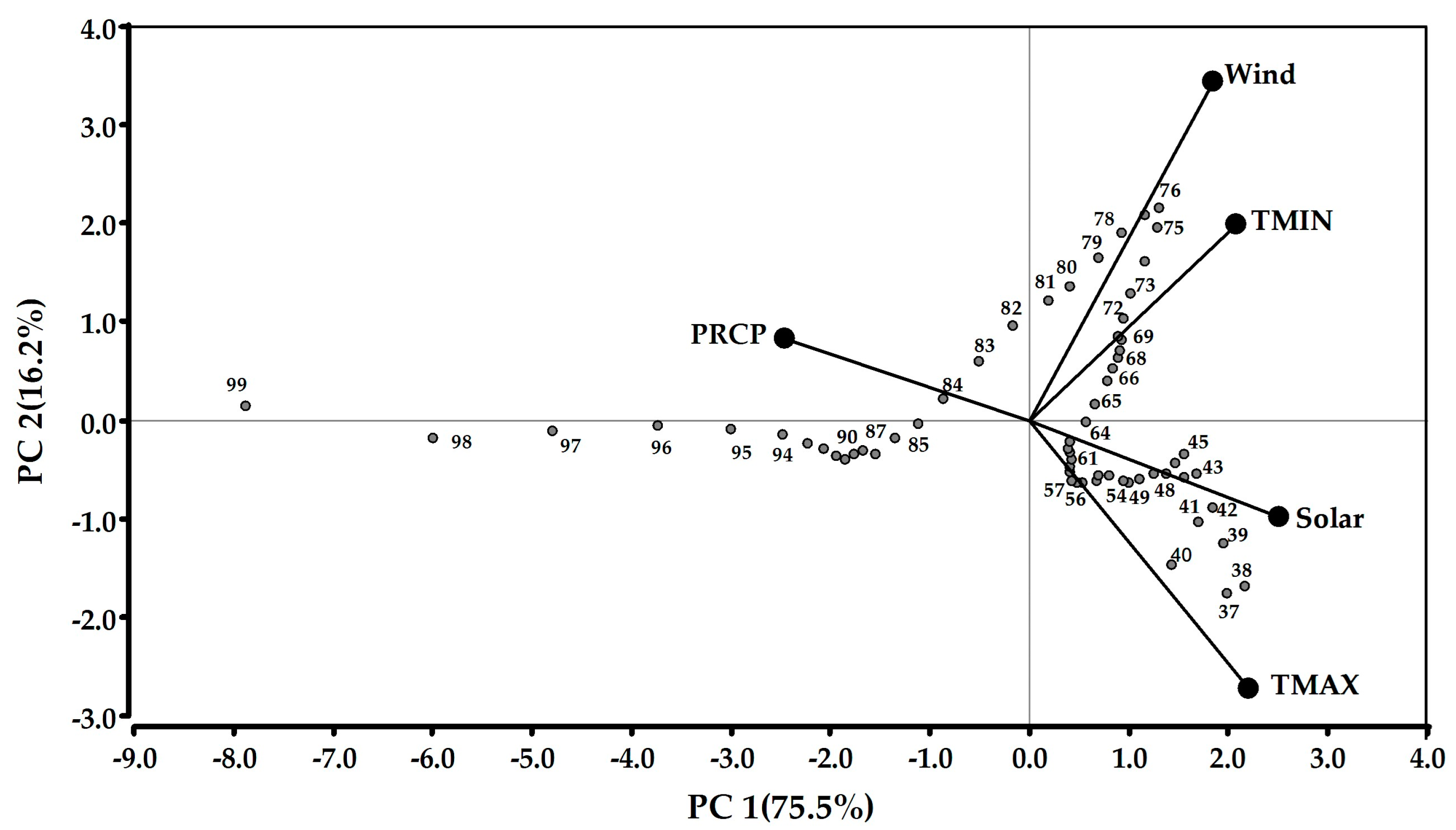
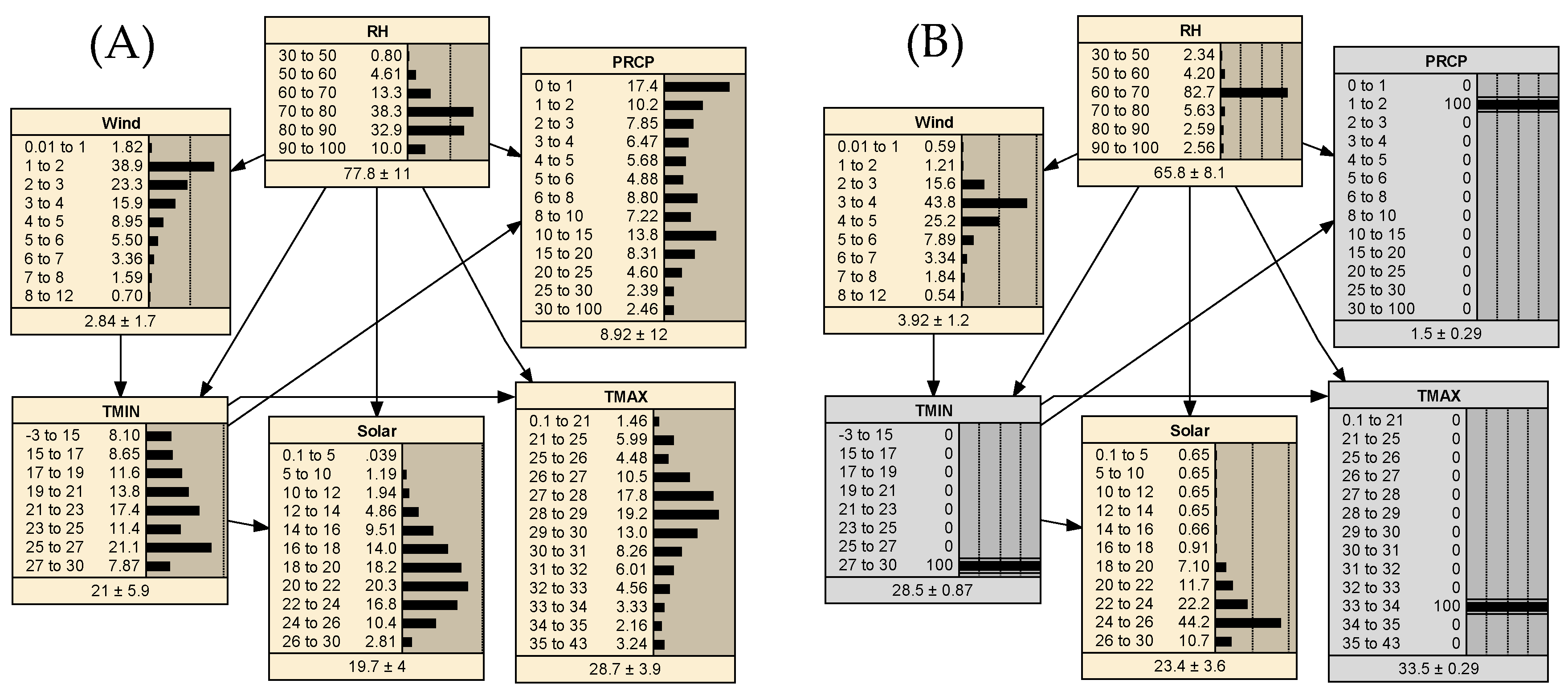
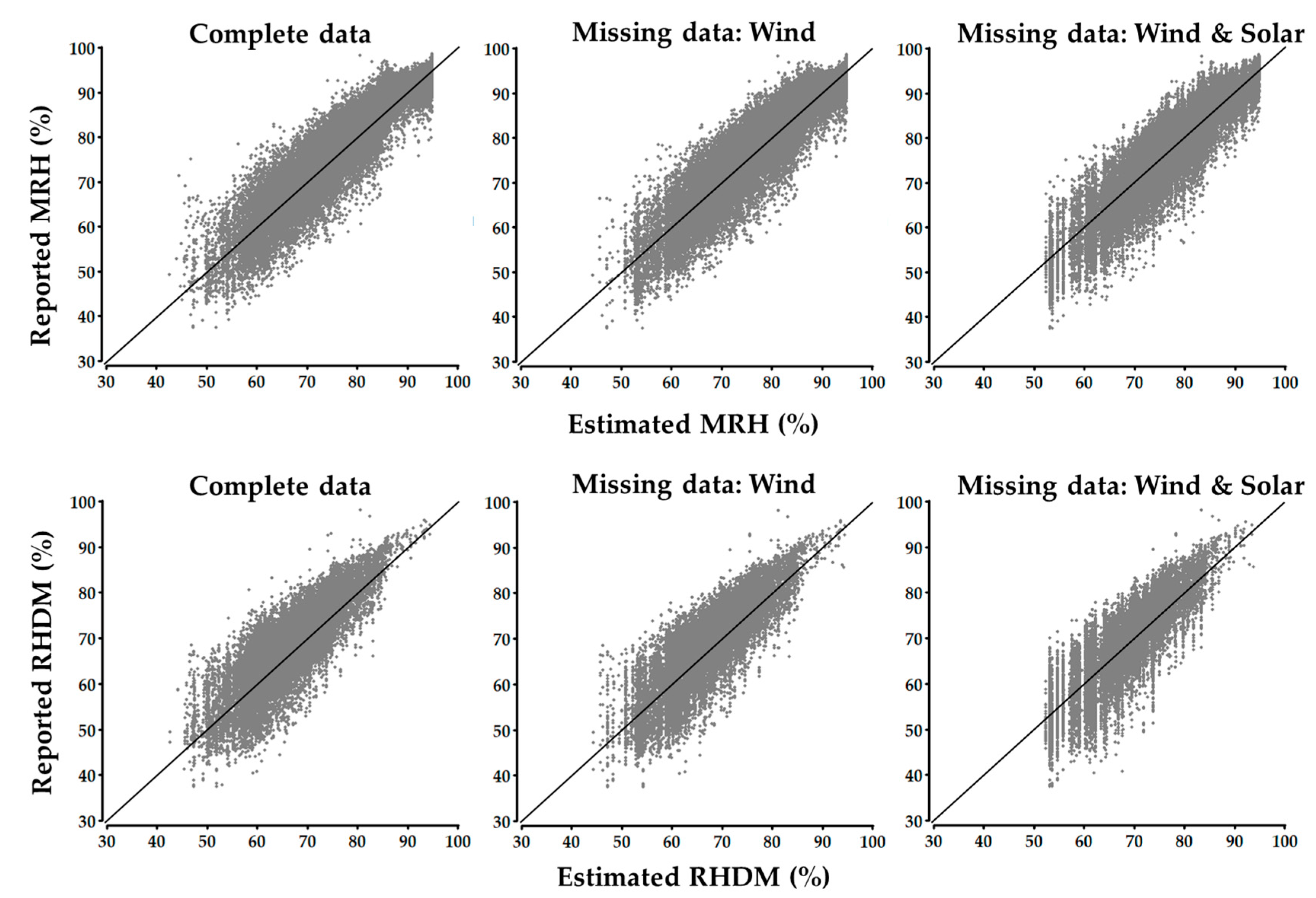
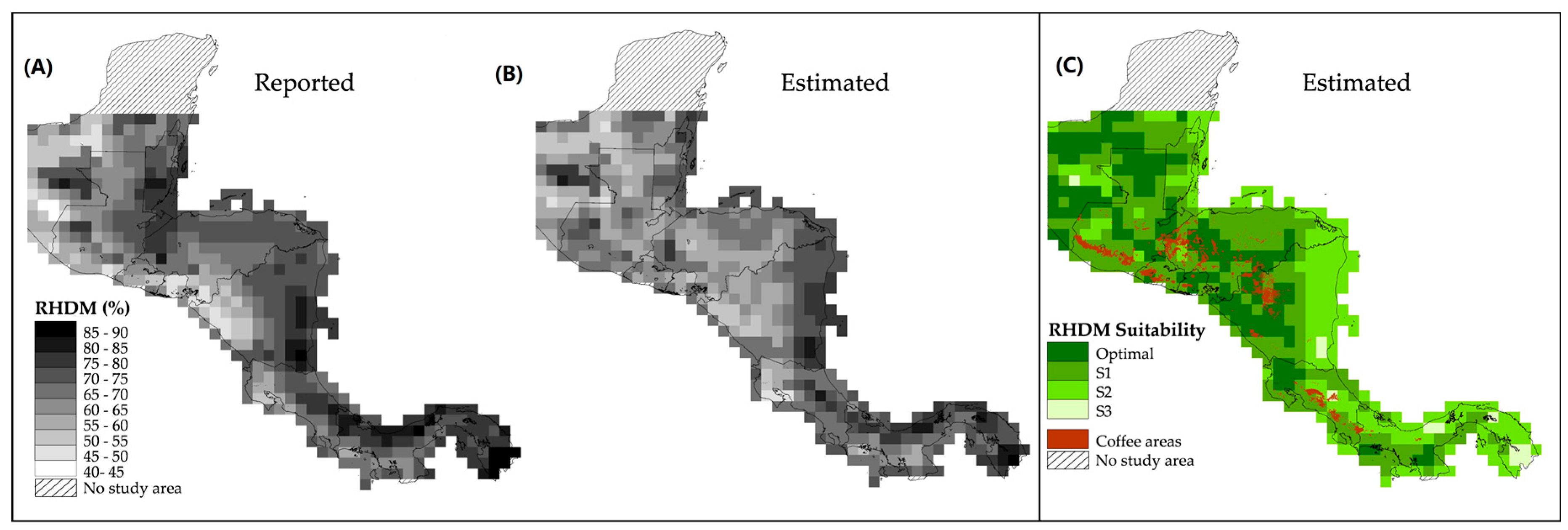
| Proxy Variables | Target Variables | |||||
|---|---|---|---|---|---|---|
| RH | PRCP | TMAX | Solar | Wind | TMIN | |
| RH | - | 25.20 | 29.30 | 22.80 | 18.50 | 4.68 |
| PRCP | 41.80 | - | 7.70 | 3.22 | 0.89 | 5.42 |
| TMAX | 33.90 | 6.67 | - | 17.60 | 7.41 | 29.60 |
| Solar | 17.90 | 2.36 | 16.00 | - | 16.60 | 21.50 |
| Wind | 13.70 | 2.18 | 1.73 | 19.10 | - | 24.90 |
| TMIN | 1.94 | 3.09 | 24.20 | 28.60 | 45.90 | - |
| Inferred Variable | Cases (Dataset) | Proxy Variables ** | Metrics | |||
|---|---|---|---|---|---|---|
| Model Building * | Validation | Known | Missing | BIAS | RMSE | |
| Monthly relative humidity | 180,530 (MRH) | 45,190 (MRH) | PRCP, TMAX, Solar, Wind, TMIN | - | −0.99 | 4.03 |
| PRCP, TMAX, Solar, TMIN | Wind | −0.52 | 4.13 | |||
| PRCP, TMAX, TMIN | Solar, Wind | −0.40 | 4.13 | |||
| Relative humidity of the driest month | 180,530 (MRH) | 18,810 (RHDM) | PRCP, TMAX, Solar, Wind, TMIN | - | −0.26 | 2.25 |
| PRCP, TMAX, Solar, TMIN | Wind | −0.76 | 4.93 | |||
| PRCP, TMAX, TMIN | Solar, Wind | −0.08 | 5.00 | |||
© 2018 by the authors. Licensee MDPI, Basel, Switzerland. This article is an open access article distributed under the terms and conditions of the Creative Commons Attribution (CC BY) license (http://creativecommons.org/licenses/by/4.0/).
Share and Cite
Lara-Estrada, L.; Rasche, L.; Sucar, L.E.; Schneider, U.A. Inferring Missing Climate Data for Agricultural Planning Using Bayesian Networks. Land 2018, 7, 4. https://doi.org/10.3390/land7010004
Lara-Estrada L, Rasche L, Sucar LE, Schneider UA. Inferring Missing Climate Data for Agricultural Planning Using Bayesian Networks. Land. 2018; 7(1):4. https://doi.org/10.3390/land7010004
Chicago/Turabian StyleLara-Estrada, Leonel, Livia Rasche, L. Enrique Sucar, and Uwe A. Schneider. 2018. "Inferring Missing Climate Data for Agricultural Planning Using Bayesian Networks" Land 7, no. 1: 4. https://doi.org/10.3390/land7010004




